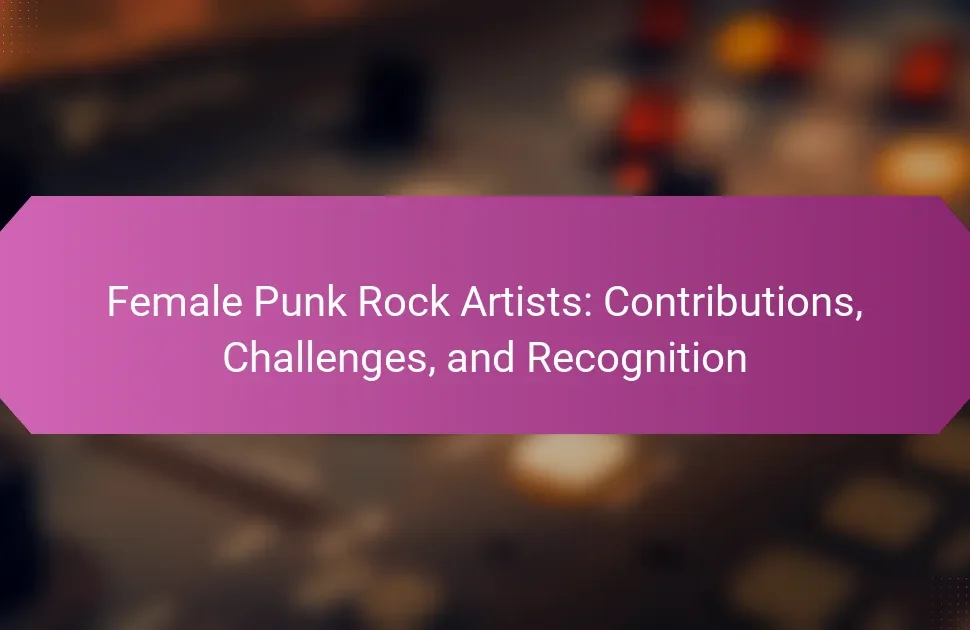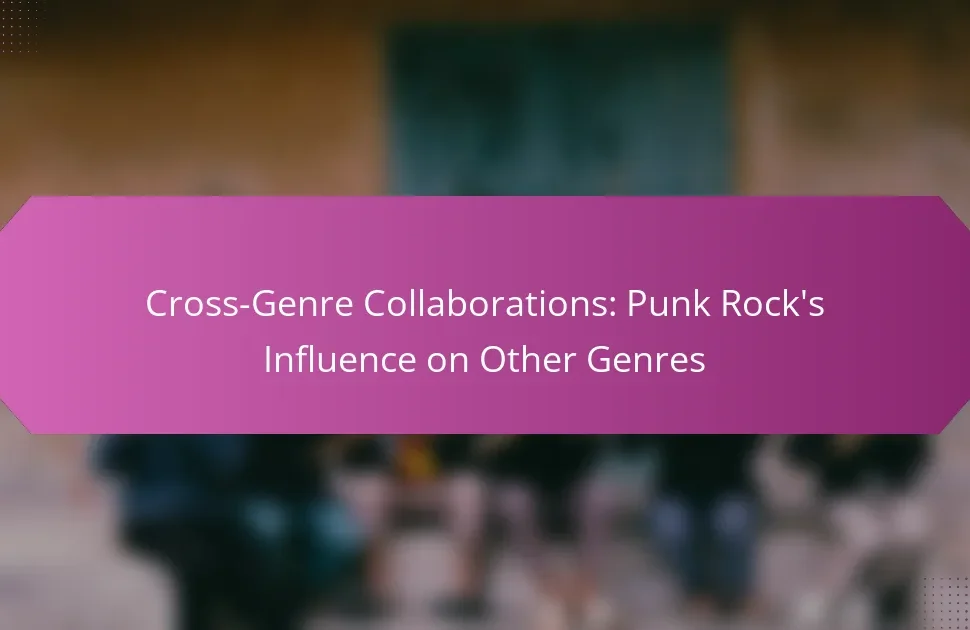Japanese punk rock is a dynamic genre characterized by its raw energy, aggressive sound, and cultural significance. This article explores its unique characteristics, influential bands like The Stalin and Shonen Knife, and the movement’s role in promoting individuality and social critique. Additionally, it examines the challenges faced by contemporary artists within the scene and highlights various subgenres that reflect its diverse influences.
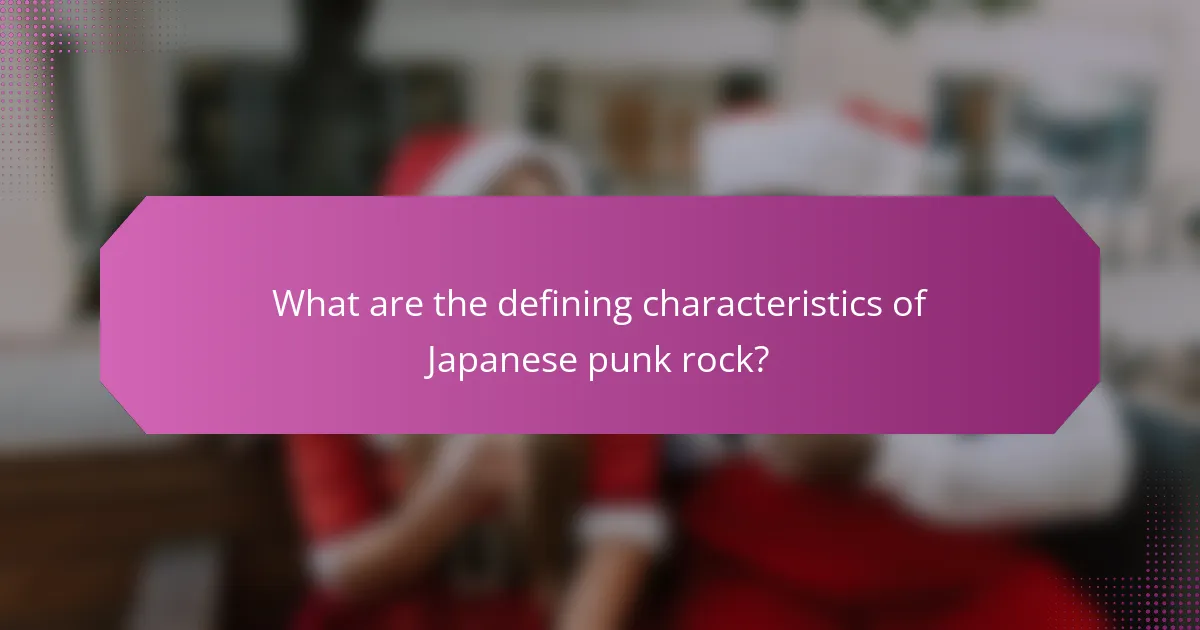
What are the defining characteristics of Japanese punk rock?
Japanese punk rock is defined by its raw energy, distinctive sound, and cultural impact. Key characteristics include fast tempos, aggressive guitar riffs, and often politically charged lyrics. Influential bands like The Stalin and Shonen Knife shaped the genre, blending traditional Japanese music elements with Western punk influences. The movement reflects a rebellion against societal norms, emphasizing individuality and self-expression.
How does Japanese punk rock differ from Western punk?
Japanese punk rock is distinguished by its distinct cultural influences and stylistic variations. Unlike Western punk, which often emphasizes rebellion and individualism, Japanese punk integrates local cultural elements and aesthetics.
Key characteristics include a focus on melodic elements and diverse subgenres, such as “Oi!” and “hardcore.” Influential bands like The Stalin and Shonen Knife showcase unique sounds that blend punk with traditional Japanese music.
Culturally, Japanese punk reflects societal issues, often addressing themes like alienation and conformity. This contrasts with Western punk’s focus on political dissent and personal freedom.
Overall, Japanese punk rock offers a unique perspective shaped by its cultural context, making it a vital part of the global punk scene.
What themes are prevalent in Japanese punk lyrics?
Japanese punk lyrics often explore themes of rebellion, social discontent, and identity. They reflect dissatisfaction with societal norms and government authority. Common motifs include anti-establishment sentiments, personal struggles, and cultural critiques. These themes resonate with Japan’s unique historical and social context, enriching the punk genre’s cultural significance.
Which instruments are commonly used in Japanese punk rock?
Electric guitars, bass guitars, and drums are commonly used in Japanese punk rock. These instruments create the raw sound and energy characteristic of the genre. The electric guitar often features distortion effects, while the bass provides a driving rhythm. Drums maintain a fast tempo, enhancing the overall intensity. Notable bands like The Stalin and Shonen Knife exemplify these instrumentations, contributing to the unique punk rock scene in Japan.
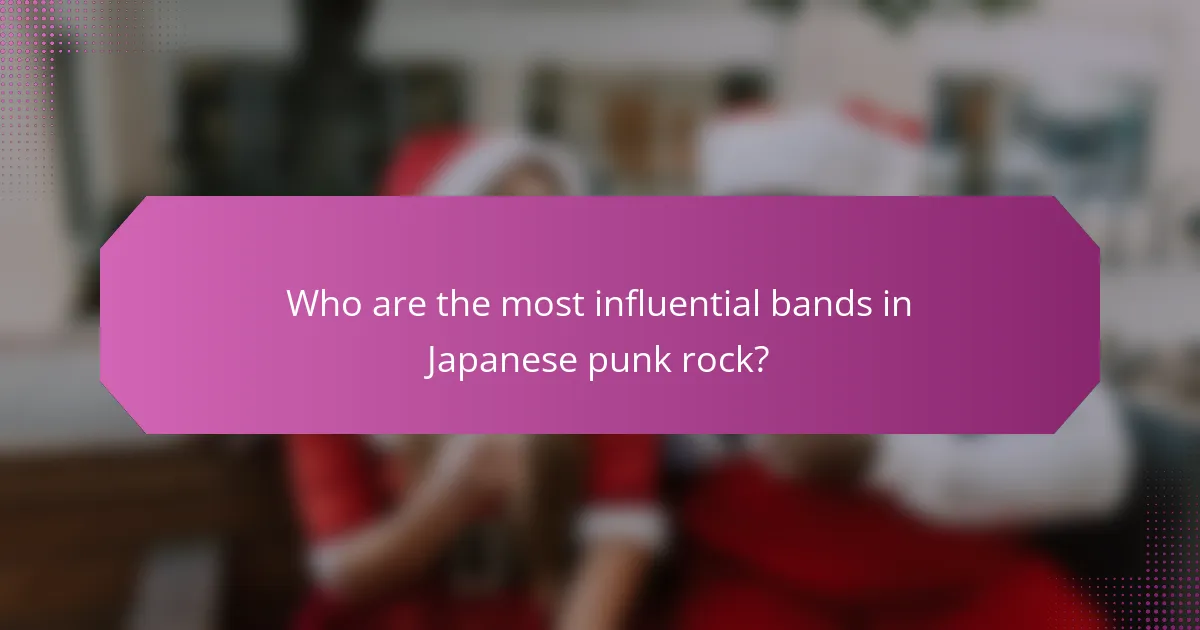
Who are the most influential bands in Japanese punk rock?
The most influential bands in Japanese punk rock include The Stalin, Gauze, and Shonen Knife. These bands shaped the genre with unique sounds and cultural messages. The Stalin, formed in 1980, is known for their aggressive style and political lyrics. Gauze, emerging in the mid-1980s, brought a raw energy that defined the hardcore punk scene. Shonen Knife, formed in 1981, infused pop melodies into punk, gaining international recognition. Each band contributed significantly to the evolution of Japanese punk rock, impacting both local and global music scenes.
What impact did The Stalin have on the genre?
The Stalin significantly impacted Japanese punk rock by introducing a raw, aggressive sound and politically charged lyrics. Their music challenged societal norms and inspired a generation of bands. The blend of punk and avant-garde elements set them apart, influencing acts like Gauze and Lip Cream. Their unique style emphasized DIY ethics, shaping the punk scene’s identity in Japan.
How did Shonen Knife contribute to the global punk scene?
Shonen Knife significantly influenced the global punk scene by blending pop melodies with punk energy. Their unique sound, characterized by catchy hooks and playful lyrics, attracted international attention. Formed in 1981, they showcased Japanese culture through their music, inspiring Western punk bands. Shonen Knife’s participation in international tours expanded their reach, fostering cultural exchange and collaboration within the punk community. Their distinct approach to punk rock contributed to the genre’s diversity and helped establish a global audience for Japanese punk music.
Which contemporary bands are shaping the future of Japanese punk rock?
Several contemporary bands are significantly shaping the future of Japanese punk rock. Notable examples include Otoboke Beaver, known for their energetic performances and feminist themes, and Hi-STANDARD, who blend melodic punk with pop influences. Other influential bands like Chai and BimBamBoo infuse diverse genres, expanding the punk rock landscape in Japan. These bands not only embody the unique characteristics of Japanese punk rock but also contribute to its cultural significance through innovative sounds and social commentary.
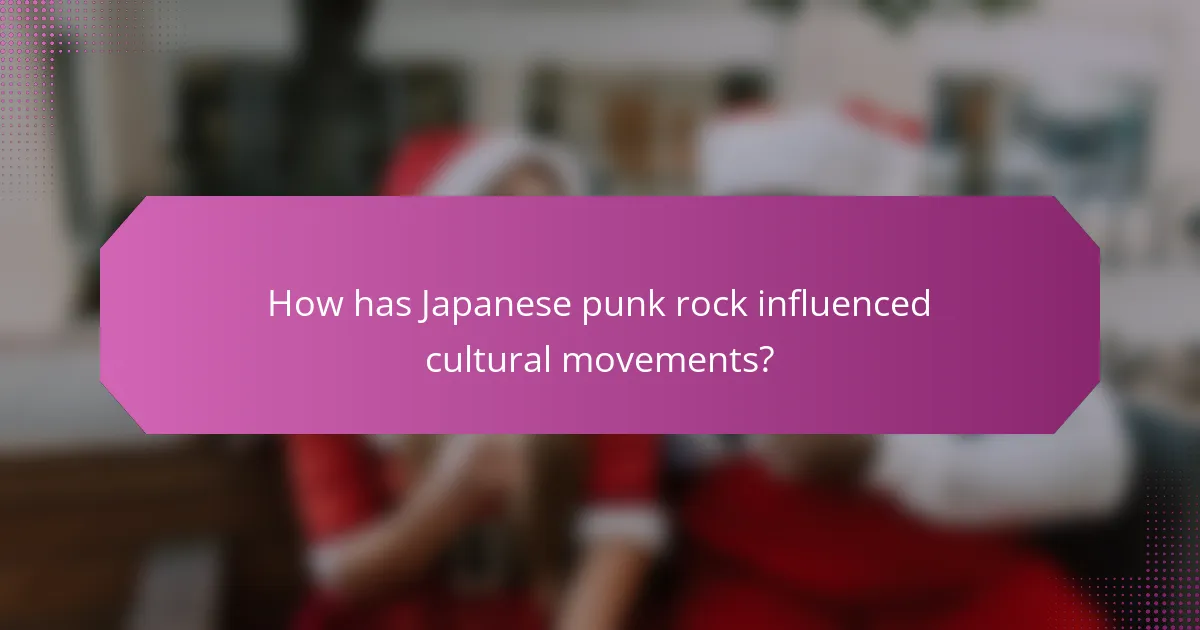
How has Japanese punk rock influenced cultural movements?
Japanese punk rock has significantly shaped cultural movements by promoting individuality and social critique. Bands like The Stalin and Shonen Knife challenged societal norms, inspiring youth activism and alternative lifestyles. This genre’s raw energy and anti-establishment messages resonated globally, influencing fashion and art. Unique attributes include its fusion with traditional Japanese music, creating a distinctive sound that reflects cultural identity. As a result, Japanese punk rock remains a vital force in contemporary cultural expressions.
What role does punk rock play in youth identity in Japan?
Japanese punk rock plays a significant role in shaping youth identity by promoting individuality and rebellion against societal norms. This genre emerged in the late 1970s and reflects a unique blend of Western influences and Japanese cultural elements. Influential bands like The Stalin and Shonen Knife have fostered a sense of community among youth, encouraging self-expression and activism. The raw energy and DIY ethos of punk rock resonate with young people seeking to challenge conformity and assert their identities in a rapidly changing society.
How does Japanese punk rock engage with social and political issues?
Japanese punk rock actively engages with social and political issues through its lyrics and performances. Bands like The Stalin and Shonen Knife address topics such as government oppression, social inequality, and youth disillusionment. This genre often incorporates a raw, rebellious sound that resonates with marginalized voices. The unique attribute of Japanese punk rock lies in its blend of traditional Japanese culture with Western punk influences, creating a distinct form of protest music. As a result, it fosters a sense of community and empowerment among listeners, encouraging them to challenge societal norms.
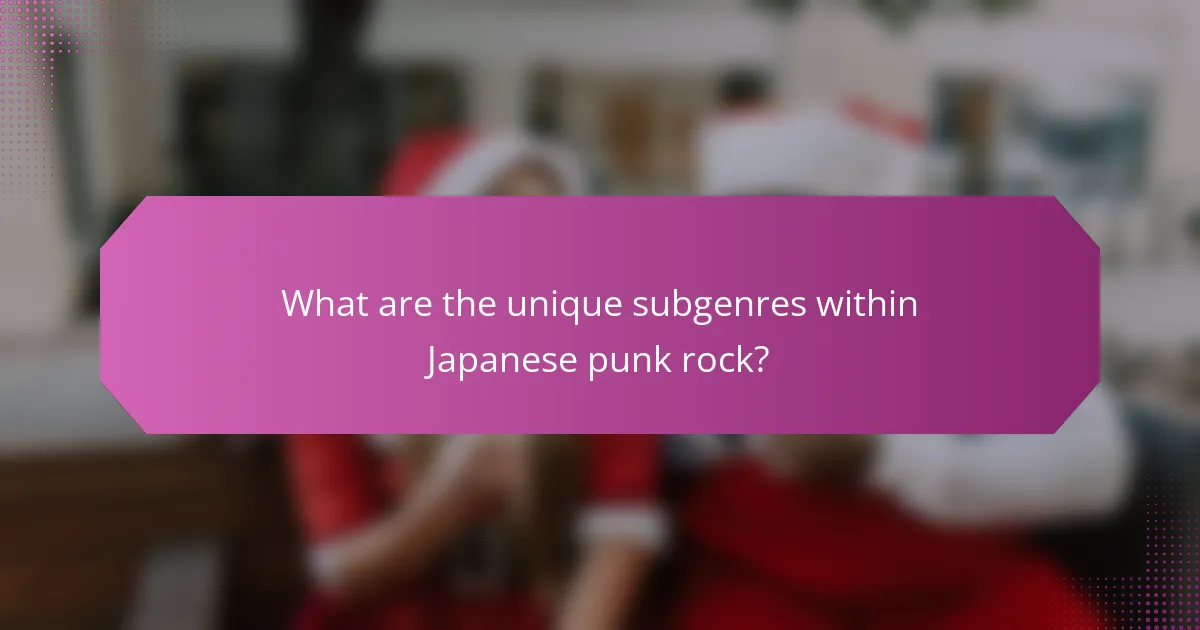
What are the unique subgenres within Japanese punk rock?
Japanese punk rock features unique subgenres that reflect diverse influences and cultural nuances. Key subgenres include:
1. **Oi! Punk** – Focuses on working-class themes and has a raw sound.
2. **Melodic Punk** – Emphasizes catchy melodies and harmonies, often with emotional lyrics.
3. **Hardcore Punk** – Characterized by fast tempos and aggressive vocals, expressing social and political messages.
4. **Post-Punk** – Blends punk with experimental sounds, exploring new musical territories.
5. **Pop Punk** – Combines punk’s energy with pop sensibilities, appealing to mainstream audiences.
6. **Garage Punk** – Features a lo-fi aesthetic, drawing from garage rock influences.
These subgenres showcase the evolution and adaptability of Japanese punk rock within its cultural context.
How does hardcore punk manifest in Japan?
Hardcore punk in Japan manifests through aggressive music, distinct fashion, and a strong DIY ethic. It emerged in the late 1970s, influenced by Western punk but adapted to Japanese culture. Bands like GISM and The Stalin exemplify this unique sound, often blending social commentary with raw energy. The scene fosters a sense of community, encouraging self-expression and resistance against societal norms.
What is the significance of visual kei in punk culture?
Visual kei significantly influences punk culture by merging fashion, music, and identity expression. This genre emphasizes flamboyant aesthetics and theatrical performances, challenging traditional punk norms. Bands like X Japan and Malice Mizer exemplify this integration, blending melodic elements with punk’s rebellious spirit. Visual kei’s unique attribute lies in its emphasis on visual presentation, making it a distinct subculture within the broader punk movement.
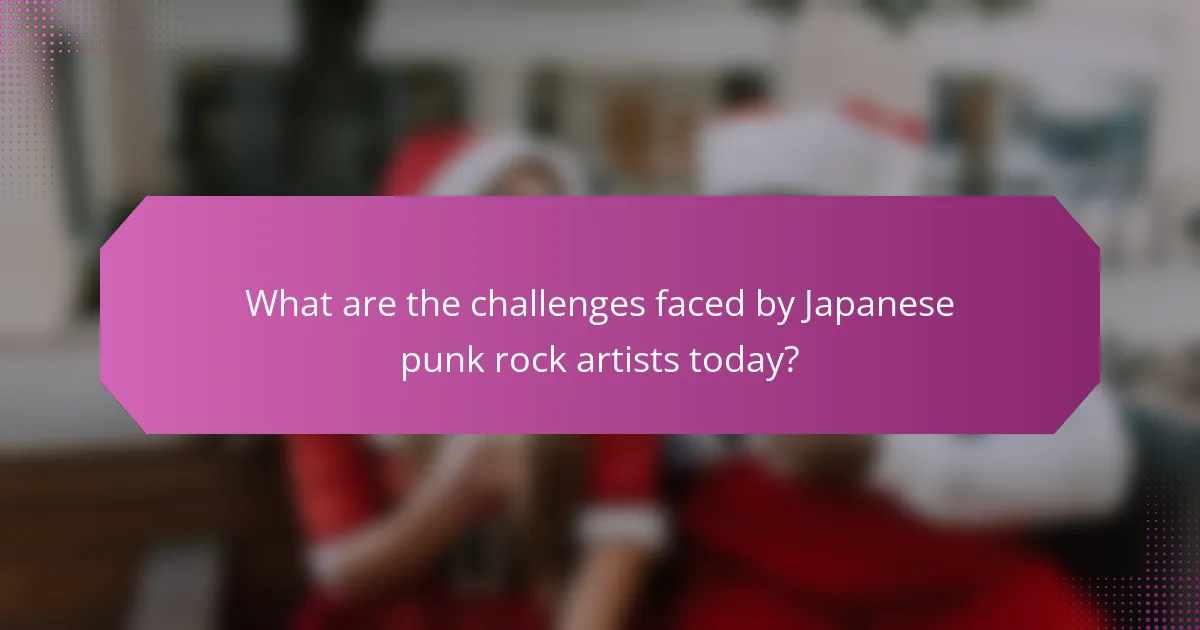
What are the challenges faced by Japanese punk rock artists today?
Japanese punk rock artists face several challenges today, including limited mainstream exposure and financial instability. The genre struggles with commercialization, making it hard for artists to maintain authenticity. Additionally, there is a lack of venues supporting punk music, which restricts performance opportunities. The cultural perception of punk in Japan often leads to misunderstandings, hindering broader acceptance. Many artists also grapple with balancing their artistic vision against societal expectations. These factors collectively impact the vibrancy and growth of the Japanese punk rock scene.
How do streaming platforms affect the reach of Japanese punk bands?
Streaming platforms significantly enhance the reach of Japanese punk bands by providing global accessibility. These platforms allow bands to share their music widely, breaking geographical barriers and attracting international fans. For instance, platforms like Spotify and Apple Music enable users worldwide to discover Japanese punk, leading to increased streaming numbers and concert attendance. The unique attributes of Japanese punk, such as its fusion of traditional and modern influences, resonate with diverse audiences, further amplifying the genre’s cultural significance. As a result, streaming services play a crucial role in the evolution and promotion of Japanese punk rock.
What are the common misconceptions about Japanese punk rock?
Many misconceptions exist about Japanese punk rock, often oversimplifying its diversity. One common myth is that it solely imitates Western punk. In reality, Japanese punk blends various influences, creating a distinct sound and style. Another misconception is that it lacks political depth. However, many bands address social issues and cultural critiques through their music. Additionally, some believe Japanese punk is a niche genre with little mainstream appeal, but it has significantly influenced broader music scenes in Japan.
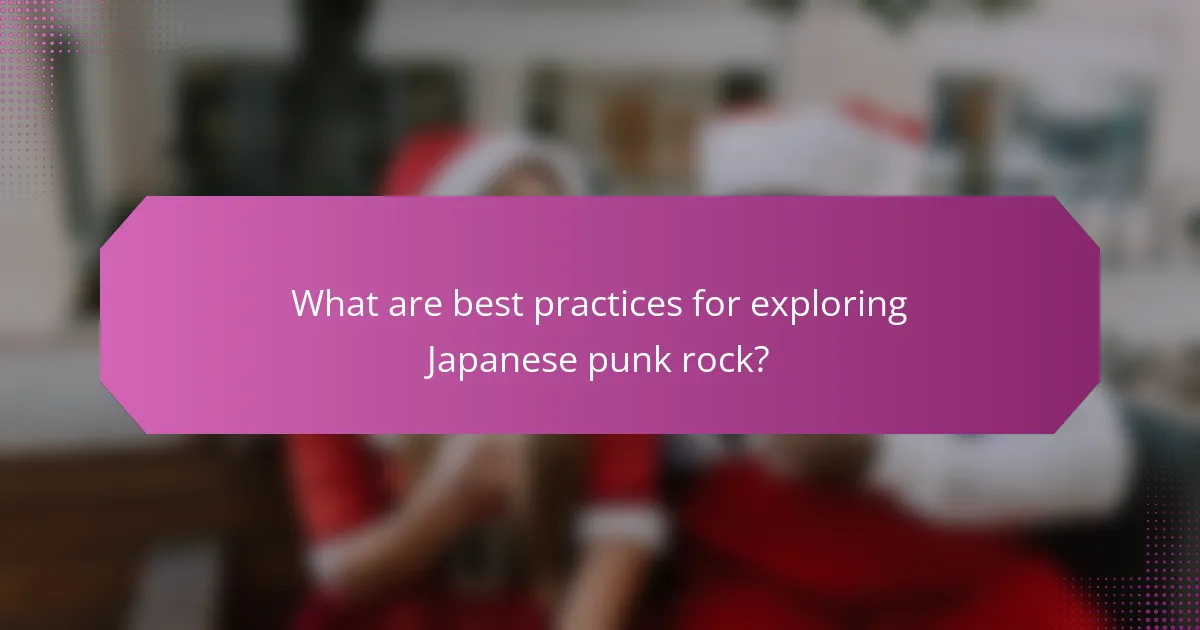
What are best practices for exploring Japanese punk rock?
To explore Japanese punk rock effectively, immerse yourself in its unique characteristics and influential bands. Start by listening to seminal albums from bands like The Stalin and Shonen Knife, which showcase the genre’s raw energy and distinct sound. Attend live shows to experience the vibrant culture and community firsthand. Engage with online forums and social media groups dedicated to Japanese punk to connect with enthusiasts and discover lesser-known artists. Read books and articles that analyze the cultural significance of the movement, emphasizing its roots in rebellion and social commentary.
How can fans support their favorite Japanese punk bands?
Fans can support their favorite Japanese punk bands by attending live shows, purchasing merchandise, and promoting their music online. Engaging with the bands on social media increases visibility and fosters community. Additionally, sharing music through playlists or streaming platforms helps reach new audiences. Supporting local venues that host these bands strengthens the punk scene. Finally, crowdfunding or participating in fan clubs can provide financial backing for tours and recordings.
What resources are available for discovering new Japanese punk music?
Many resources for discovering new Japanese punk music include online platforms, music blogs, and social media. Websites like Bandcamp and SoundCloud feature emerging artists. Additionally, Japanese music blogs often highlight underground scenes. Social media platforms, especially Twitter and Instagram, connect fans and artists directly. Events like live shows and festivals also serve as vital points for discovering new music.

